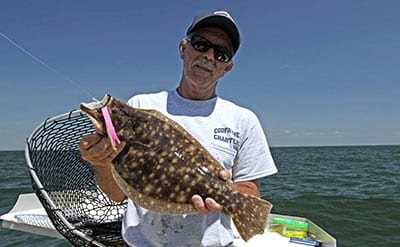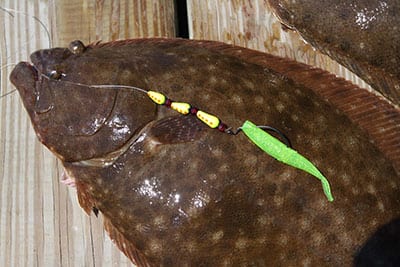
By Tom Schlichter
Chartreuse, hot pink, fluorescent yellow, day-glo green, nuclear chicken; it sounds like some sort of new wave Crayola round-up. For fishermen schooled in the belief that matching the hatch and presenting baits and lures in a natural manner are major keys to success, the simple existence of such hues on a lure or bait boggles the mind. Radiant orange! What can it possibly mimic in a fish’s world? Foul weather gear adrift at sea?
Quite frankly, some of today’s newest hot colors seem other-worldly – but it turns out these resplendent colors can and do catch fish. In fact, they can tip the scales in your favor when the old stand-bys are looking really drab.
WHY THEY WORK
Understanding why these hot colors work is the key to using them in the right place at the right time. As with more traditional shades, hot hues have to be combined with the right type of lure or bait, and a presentation the fish will accept, to be of any value. But that is no more difficult than matching up the standard colors with the right options once you have a feel for when the newer variations work best. In short, all you are doing by adding these colors to your arsenal is expanding your options.

Plain and simple, hot colors are at their best when fished in murky or discolored water. File this under the heading “fish can’t catch ‘em if they can’t find ‘em.”
Another factor that may account for the productivity of bright colors is that they simply stand out in a crowd. In the briny world, baitfish that don’t blend in out are quickly consumed – ever catch an albino fish of any sort? Perhaps seeing such a bright color draws an instinctively aggressive strike from predators that recognize such colors as a way to distinguish a single fish from a vast school of minnows which together look like one big underwater cloud.
I’ve started using hot colors on some of my plugs when I fish for stripers on late night tides and have scored very well with small plugs. The larger plugs have done okay, but not noticeably better than their drab matches. One thing I do love about using any bright colored plug at night is that I can often see my lure working in the water as it gets close to the boat or shore. That makes it easier to check the action of my offering, ensuring that it is running straight with just the right amount of side-to-side wiggle – a feat that is extremely hard to accomplish with a jet-black lure on a moonless night. If dark and bright lures are going to score the same, I’ll opt for the brighter ones because they are easier to track and tune.
This year I plan to experiment a little more in the plugging area, possibly adding a small splotch of hot color to my standard black and silver plugs. Perhaps a small dot just behind the gills will help fish better focus on my lure as they move in for the attack. I may add a few splotches of color to my tins as well, maybe a hot pink or bright yellow spot at the tail end of a spoon just ahead of the hook.
THERE’S A REASON FOR PINK

Although I find that chartreuse, bright yellow and day-glo blue can somewhat imitate the color patterns of certain species of baitfish such as sand eels, spearing and mullet, I actually find hot pink a really interesting match for some Northeast fodder.
Several years ago, I found that hot pink bucktails were catching up fluke, stripers, blues and weakfish shallow coastal bays ranging from Rhode Island to southern New Jersey. When I took home a few I managed for dinner and performed autopsies, I discovered they were full of baby calico crabs. These crabs are reddish-pink in color, and when you work a hot pink jig next to one along the bottom in shallow water, it is amazing how closely they resemble each other. Since then, I’ve been using hot pink bucktails tipped with squid to enjoy some excellent fishing for summer flatties and bass inside bays up and down the coast during late July and early August – the same time that baby calicos seem to suddenly appear on the scene each year.
In addition to the calicos, hot pink jigs also imitate to some degree baby sea robins, another favorite target of inshore predator fish and, as already noted, live squid – which perhaps explains the propensity of this color bucktail to tempt large fluke and stripers early in the season before spearing, sand eels and other small baitfish set up in the bays.
DON’T TOSS OUT TRADITION

While it is clear that hot colors can add to your success if used under the right conditions, don’t toss away those standard colors just yet.
Overall, black is still the universal starting point when plugging stripers, blues and weakfish at night. White and plain yellow bucktails still work for most predator species under just about any water conditions, and natural colors or patterns designed to mimic the real thing continue to produce just as they always have.
Silver and gold are still great color choices when you toss tins, and white, yellow and blue still account for the vast majority of striped bass, weakfish and bluefish taken on popping plugs. The time-tested theorem of lighter colors on lighter days and darker colors on darker days holds true as ever.
Still, when the fishing slows down, the water grows dingy, or you just feel like trying something a little bit different, experiment with a splash of hot color. It might just result in a bigger splash at the end of your line.









